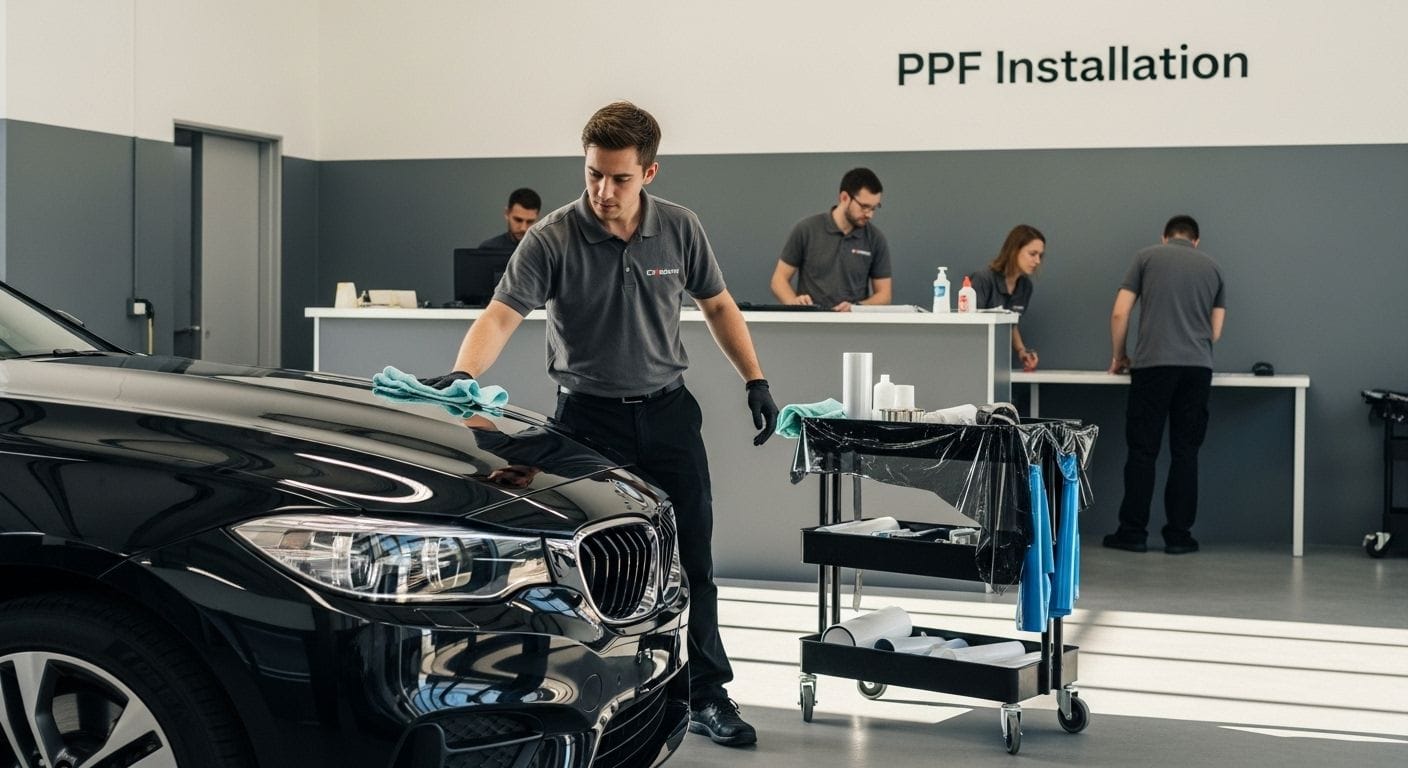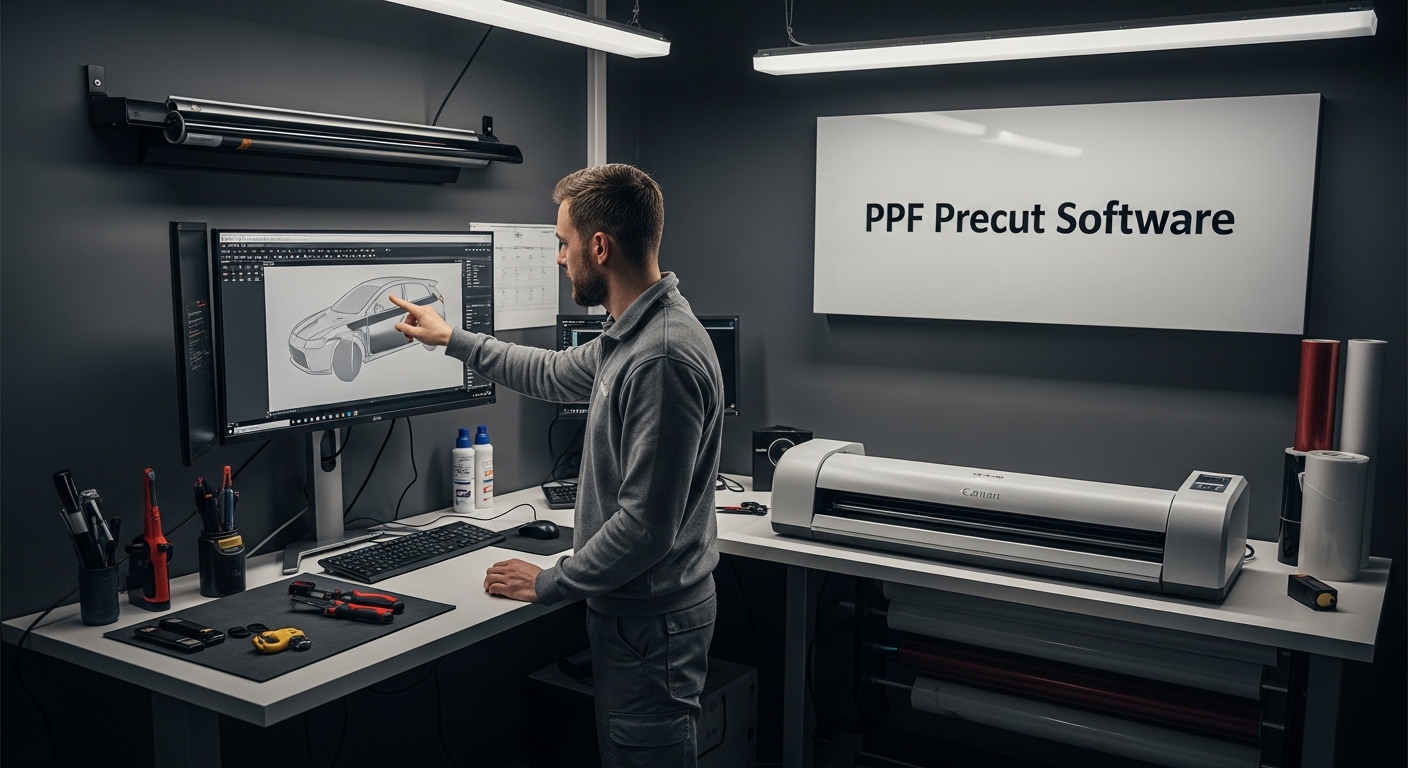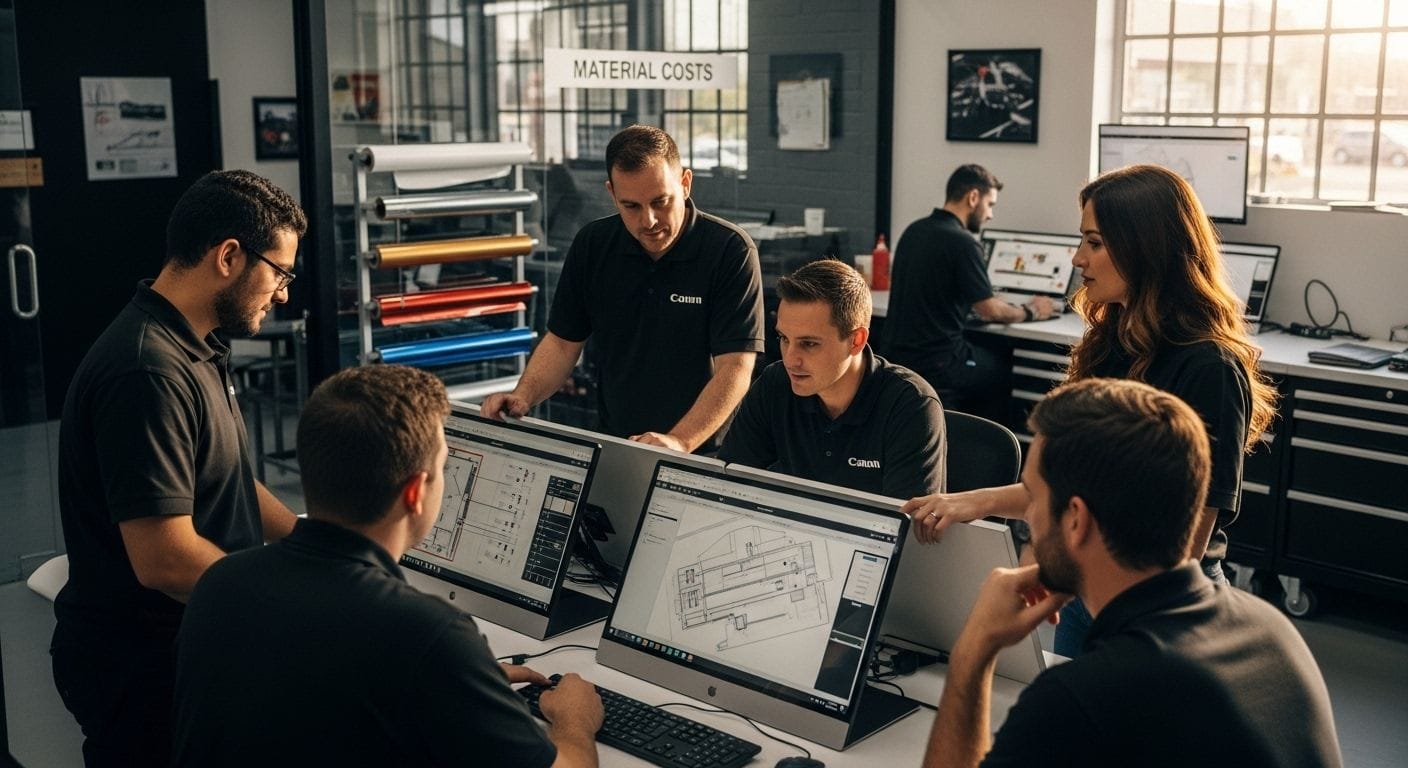
Choosing the right plotter machine for Paint Protection Film cutting can make or break the success of an automotive installation business. Some machines blaze through over 800 millimetres per second with pinpoint precision and support material thickness up to 59 mil, so speed and strength are quite literally off the charts. Yet raw cutting power only scratches the surface. The real advantage goes to those who master clever software integration and pattern libraries, giving businesses a sharp edge where it matters most.
Table of Contents
- Key Features Required For PPF Cutting
- Top Plotter Machines Reviewed And Compared
- Choosing The Best Plotter For Your Business Needs
- Expert Tips For Efficient PPF Installation
Quick Summary
| Takeaway | Explanation |
|---|---|
| Choose plotters with precision cutting technology | Select machines featuring Automatic Registration Mark systems for better accuracy and reduced waste. |
| Assess business volume for plotter selection | Identify your monthly print capacity to ensure the plotter meets current and future needs. |
| Prioritise software compatibility | Choose plotters that offer extensive pattern libraries and cloud-based updates for enhanced operational efficiency. |
| Implement meticulous preparation for installation | Proper surface cleaning and preparation are vital for ensuring optimal film adhesion and longevity during PPF installation. |
| Regular calibration maximises performance | Consistently calibrate your plotter and update software to maintain precision cutting and efficiency in operations. |
Key Features Required for PPF Cutting
Choosing the right plotter machine for Paint Protection Film (PPF) cutting demands careful consideration of several critical technical specifications that directly impact installation precision and efficiency. Professional installers need machines that offer unparalleled accuracy, robust performance, and comprehensive cutting capabilities to deliver exceptional vehicle protection results.
Precision Cutting Technology
Accurate cutting begins with advanced sensor and tracking technologies. Modern PPF plotters must incorporate Automatic Registration Mark (ARMS) systems that enable precise material alignment and tracking. Research from automotive customization experts indicates that cutting plotters with enhanced ARMS technology can dramatically reduce material waste and improve pattern reproduction accuracy. The best machines offer cutting speeds up to 58.5 inches per second with cutting forces reaching 600g, ensuring clean, crisp edges for complex vehicle panel designs.
The technical capabilities extend beyond raw speed. Professional-grade plotters must support multiple material thicknesses and types. According to specialized PPF equipment manufacturers, top-tier machines can handle material thicknesses up to 59 mil, accommodating various film brands like 3M and LLUMAR with consistent performance.
Advanced Control and Connectivity
Today’s PPF cutting plotters are not just mechanical devices but sophisticated technological solutions. Key features include:
- User Interface: Intuitive 3-inch LCD control panels allowing quick configuration and real-time monitoring
- Dual Configuration: Ability to save and switch between multiple user profiles and cutting settings
- Network Connectivity: Optional Ethernet capabilities enabling remote operation and management across multiple installation stations
These features transform plotters from simple cutting machines into intelligent workflow optimization tools. Installers can rapidly adapt to different vehicle models, film types, and client specifications without extensive manual recalibration.
Software Compatibility and Pattern Libraries
The most advanced PPF cutting machines are distinguished by their software ecosystem. Compatibility with comprehensive pattern libraries, cloud-based updates, and AI-driven design tools has become a critical selection criterion. Our guide on advanced PPF cutting software provides deeper insights into how software integration can revolutionize installation workflows.
Professional installers should prioritize plotters offering:
- Extensive pre-designed vehicle template libraries
- Customizable pattern generation capabilities
- Regular software updates
- Cloud-based pattern synchronization

By selecting a plotter that excels in precision cutting technology, advanced control features, and robust software integration, automotive protection film professionals can ensure superior installation quality, minimize material waste, and significantly enhance their operational efficiency.
Top Plotter Machines Reviewed and Compared
Selecting the optimal plotter machine for Paint Protection Film (PPF) cutting requires a comprehensive understanding of the top performers in the market. Professional installers need detailed insights into machines that deliver exceptional precision, performance, and reliability.
High Performance Professional Machines
Research from manufacturing experts reveals several standout plotter machines in the PPF cutting market. The Graphtec FC8000 series emerges as a premier choice, offering sophisticated cutting capabilities tailored for automotive protection film installations. Its robust design supports multiple film types and delivers consistently precise results.
Another notable contender is the GCC Jaguar V J5-132LX, which distinguishes itself with exceptional cutting speed and versatility. According to precision cutting equipment specialists, machines like the GR8000-140 represent the cutting edge of film processing technology, featuring maximum cutting widths up to 1290mm and speeds reaching 800mm per second.
Comparative Performance Metrics
Professional installers should evaluate plotters across several critical performance dimensions:
- Cutting Speed: Ranges from 58.5 to 800 inches per second
- Cutting Force: Adjustable settings between 0-600g
- Material Compatibility: Supporting film thicknesses from 20 to 59 mil
- Software Integration: Cloud-based pattern libraries and AI design tools
Our comprehensive software guide provides additional context on how software capabilities complement hardware performance, enabling more intelligent and efficient cutting workflows.
Advanced Machine Recommendations
To help quickly compare the top professional PPF plotter machines mentioned, here’s a comparison table outlining their key strengths and use cases:
| Machine Name | Key Strengths | Best For |
|---|---|---|
| Graphtec FC8000 | Precision cutting, user-friendly interface | Precision, all-round professional use |
| GCC Jaguar V J5-132LX | High-volume speed, versatility | High-volume operations |
| Roland VersaCAMM VS-540i | Complex panel designs, advanced capabilities | Intricate design applications |
| USCutter TITAN | Handles diverse film materials, robust build | Versatility, mixed material handling |
For professional installers seeking top-tier performance, recommended machines include:
- Graphtec FC8000: Best for precision cutting and user-friendly interfaces
- GCC Jaguar V J5-132LX: Ideal for high-volume installation environments
- Roland VersaCAMM VS-540i: Excellent for complex vehicle panel designs
- USCutter TITAN: Robust machine for diverse film material processing
Each machine offers unique strengths, and the ideal selection depends on specific installation requirements, budget constraints, and workflow complexity. Professional installers should prioritize machines that not only deliver exceptional cutting accuracy but also integrate seamlessly with their existing software and operational processes.
Choosing the Best Plotter for Your Business Needs
Selecting the right plotter machine for Paint Protection Film (PPF) cutting is a strategic decision that directly impacts your business’s operational efficiency, quality of service, and long-term profitability. Professional installers must approach this investment with a comprehensive understanding of their specific business requirements and future growth potential.
Assessing Business Volume and Capacity Needs
According to print technology experts, understanding your monthly print volume is crucial for selecting the appropriate plotter. Businesses typically fall into distinct capacity categories:
- Low-Capacity Workflows: 2,000 to 3,000 square feet monthly
- Medium-Capacity Operations: 4,000 to 6,000 square feet monthly
- High-Volume Installations: 6,000 to 10,000 square feet monthly

By accurately mapping your current and projected workflow, you can invest in a plotter that matches your business’s specific demands without overspending or experiencing performance limitations. Large format printing specialists recommend carefully evaluating print resolution, speed, and media compatibility to ensure optimal performance.
Critical Technical Considerations
Beyond volume, professional installers must scrutinize several technical specifications that directly influence operational efficiency:
- Print Resolution: Smaller jobs require around 300 dpi, while complex projects need at least 100 dpi
- Media Compatibility: Ability to handle diverse film thicknesses and types
- Software Integration: Seamless connection with design and pattern libraries
Our comprehensive software guide offers deeper insights into how software capabilities can enhance your plotter’s performance and expand your business capabilities.
Investment and Scalability Strategy
Industrial printing technology research emphasizes that choosing a plotter is not merely about current needs but future growth potential. Consider these strategic investment factors:
- Initial cost versus long-term value
- Potential efficiency gains
- Waste reduction capabilities
- Upgrade and expansion potential
- Industry-specific technological requirements
A high-quality plotter might represent a significant upfront investment, but its ability to deliver consistent, precise results can generate substantial returns through improved client satisfaction, reduced material waste, and enhanced operational efficiency.
Ultimately, the best plotter for your business is one that not only meets your current technical requirements but also provides flexibility to adapt and grow with your evolving automotive protection film installation services. Careful evaluation of volume, technical specifications, and long-term strategic potential will guide you toward making an informed, profitable decision.
Expert Tips for Efficient PPF Installation
Mastering Paint Protection Film (PPF) installation requires more than just high-end equipment. Professional installers must develop a strategic approach that combines technical skill, precision techniques, and advanced technological understanding to deliver exceptional results.
Precision Preparation and Surface Management
For efficient Paint Protection Film (PPF) installation, following a systematic preparation process is essential. The table below summarises the key surface preparation steps prior to installation:
| Step | Purpose |
|---|---|
| Thorough surface cleaning | Remove dirt and contaminants to enable strong adhesion |
| Comprehensive paint decontamination | Eliminate embedded particles preventing film application |
| Paint correction (microscopic defects) | Remove imperfections for flawless surface finish |
| Create immaculate, ready surface | Ensure optimal adhesion and film longevity |
Successful PPF installation begins long before the film touches the vehicle surface. Technical experts recommend implementing a meticulous preparation process that ensures optimal film adhesion and longevity.
Key preparation steps include:
- Thorough surface cleaning using specialized automotive detailing solutions
- Comprehensive paint decontamination
- Eliminating microscopic imperfections through professional-grade paint correction techniques
- Creating an immaculate surface that allows perfect film adhesion
According to automotive protection technology research, advancements in precision-cutting technology are dramatically simplifying installation processes, reducing overall installation time and minimizing material waste.
Advanced Software and Calibration Techniques
Modern PPF installations demand sophisticated software integration and consistent machine calibration. Our custom pattern creation guide provides comprehensive insights into leveraging cutting-edge software capabilities.
Professional installers should focus on:
- Regular plotter calibration
- Understanding comprehensive software features
- Engaging with online tutorials and professional forums
- Continuously updating software and machine configurations
Installation Best Practices
Beyond technical preparation, successful PPF installation requires a combination of skill, patience, and systematic approach:
- Use appropriate environmental conditions (controlled temperature and humidity)
- Work in clean, dust-free environments
- Apply films using professional-grade squeegees and application tools
- Develop consistent hand techniques for bubble-free application
- Allow adequate curing time after installation
Implementing these expert strategies transforms PPF installation from a routine task to a precision craft. By combining advanced technological tools, meticulous preparation, and refined techniques, professional installers can consistently deliver superior vehicle protection results that meet the highest industry standards.
Remember, excellence in PPF installation is not just about the equipment you use, but how strategically and skillfully you employ those tools to achieve perfection.
Frequently Asked Questions
What features should I look for in a plotter machine for PPF cutting?
When choosing a plotter for Paint Protection Film cutting, look for precision cutting technology, advanced control and connectivity features, and compatibility with comprehensive software and pattern libraries to ensure optimal performance and efficiency.
How does cutting speed affect PPF installation?
Cutting speed significantly impacts PPF installation efficiency. High-performance plotters can cut at speeds of up to 800 millimetres per second, enabling quicker job completion and increasing overall productivity in high-demand environments.
Why is software compatibility important for plotters used in PPF cutting?
Software compatibility is essential as it allows access to extensive pattern libraries, cloud-based updates, and AI-driven design tools, which enhance operational efficiency and support precise, custom solutions for various vehicle models and film types.
What are the key technical specifications to consider when selecting a plotter for my business?
Key specifications include cutting speed and force, material compatibility (thicknesses and types), print resolution requirements, and the ability to connect and integrate with existing design software to streamline workflow and improve output quality.
Maximise Precision and Productivity With AEONCUT’s PPF Pattern Solutions
If you are searching for the perfect balance between advanced plotter hardware and exceptional cutting results, this is where your journey becomes effortless. The challenges discussed in the article—achieving clean, accurate PPF cuts, minimising material waste, and keeping up with the latest pattern software—can all be addressed with trusted pattern resources. Explore our PPF precut pattern library, meticulously crafted for the demands of professional installers and serious automotive enthusiasts.

You do not have to compromise on efficiency or pattern quality. Unlock unlimited access to ever-expanding vehicle patterns, cloud-based updates and all the tools that ensure seamless integration with your plotter setup. Upgrade your workflow right away and discover a smarter path to perfect PPF installation by visiting AEONCUT’s main site.
Recommended
- PPF Cutting Software: Essential Guide for Installers 2025 – AEONCUT PPF Pre-cut Cutting software
- Top 5 PPF and Tint Cutting Software for Professionals 2025 – AEONCUT PPF Pre-cut Cutting software
- Best PPF Software 2025: Top Picks for Auto detailing businesses – AEONCUT PPF Pre-cut Cutting software
- How to Create Custom PPF Patterns Using Aeoncut: Step-by-Step Guide – AEONCUT PPF Pre-cut Cutting software




